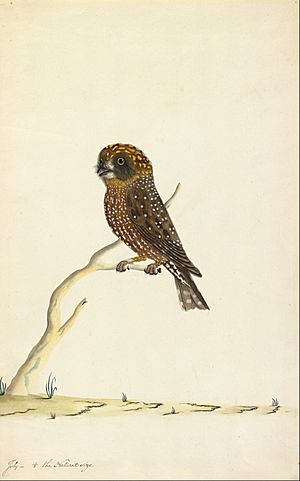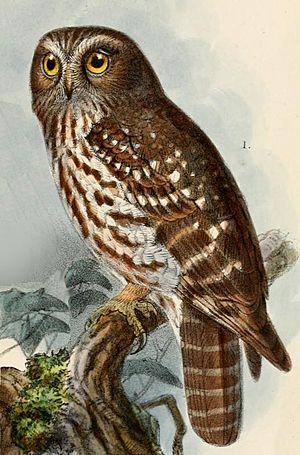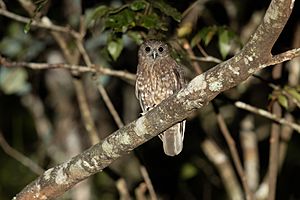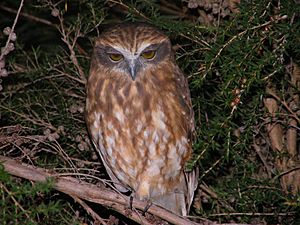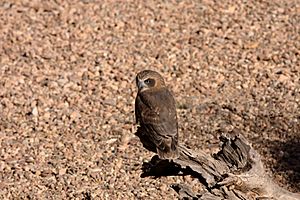Australian boobook facts for kids
Quick facts for kids Australian boobook |
|||
|---|---|---|---|
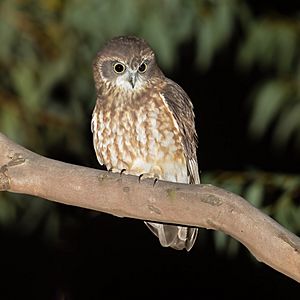 |
|||
| Subspecies boobook, Oatley Park, New South Wales |
|||
| Conservation status | |||
| Scientific classification | |||
| Genus: |
Ninox
|
||
| Species: |
boobook
|
||
| Subspecies | |||
|
11, see text |
|||
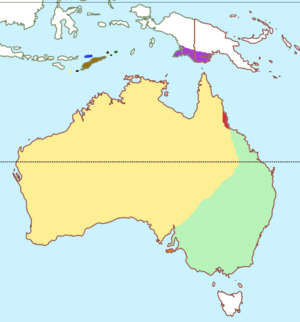 |
|||
| N.b.boobook, N.b.ocellata, N.b.halmaturina, N.b.lurida, N.b.fusca, N.b.pusilla, N.b. plesseni, N.b.rotiensis, N.b.moae, N.b.cinnamomina |
|||
| Synonyms | |||
|
|||
The Australian boobook (Ninox boobook) is a type of owl found in Australia, southern New Guinea, and some islands like Timor. It was first described in 1801. For a long time, people thought it was the same species as the morepork from New Zealand. But in 1999, scientists realized they were different.
This owl gets its name from its special "boo-book" call. It's the smallest owl living on the Australian mainland. It usually has dark-brown feathers with light spots. Its eyes can be grey-green or yellow-green.
Australian boobooks are mostly active at night. They sometimes hunt at dawn or dusk. During the day, they rest in hidden spots in tree leaves. They eat insects and small animals. They hunt by diving down from tree branches. These owls lay their eggs in tree hollows from late winter to early summer. The International Union for Conservation of Nature says the Australian boobook is a species of "least concern". This means it's not currently endangered.
Meet the Australian Boobook Owl
What's in a Name?
The Australian boobook was first described by an English bird expert named John Latham in 1801. He called it Strix boobook. The name "boobook" comes from a local Aboriginal language, Dharug. It's how they said the bird's name.
The name "Australian boobook" became official in 2019. This happened when some owls from Indonesia were recognized as separate species. People also call this owl "mopoke" because of its two-note call. Early settlers in Australia sometimes called it the "cuckoo owl". They thought its call sounded like the common cuckoo.
Different Types of Boobooks
Scientists have found that the Australian boobook is different from the morepork found in New Zealand. They also think it's different from the Tasmanian boobook. In fact, some studies suggest the Australian boobook is closely related to the barking owl.
There are eight recognized types, or subspecies, of the Australian boobook. These subspecies are slightly different depending on where they live. For example, some might be darker or have different markings.
Subspecies Spotlight
Here are some of the recognized subspecies:
- N. b. boobook: This is the most common type. It lives across mainland Australia, from southern Queensland down to South Australia.
- N. b. cinnamomina: Found on islands like Tepa and Babar. It has reddish-brown feathers and is smaller.
- N. b. halmaturina: This one lives on Kangaroo Island. It has darker, more reddish feathers than other types.
- N. b. lurida: Also known as the red boobook. It's a unique type from north Queensland. It's small and dark with a reddish color.
- N. b. moae: Found on islands like Moa and Leti. It's darker than the main subspecies.
- N. b. ocellata: This subspecies lives across northern and western Australia. It's generally lighter in color.
- N. b. pusilla: Found in southern New Guinea. It looks like ocellata but is smaller.
- N. b. remigialis: Lives on the Kai Islands. Not much is known about this one. Its call sounds a bit like the barking owl.
Some owls that used to be considered subspecies of the Australian boobook are now seen as their own species. These include the Rote boobook, Timor boobook, and Alor boobook.
What Does the Australian Boobook Look Like?
The Australian boobook is the smallest owl in mainland Australia. It is about 27 to 36 centimeters (11 to 14 inches) long. It has short, round wings and a short tail. When it flies, it looks very compact.
Owls from cooler, southern parts of Australia tend to be larger. For example, boobooks near Canberra weigh around 300 grams (10.6 ounces). Those from warmer areas like Cape York Peninsula weigh about 200 grams (7 ounces). Female boobooks are usually a bit bigger and heavier than males.
These owls have dark brown heads and upper bodies. They have white marks on their shoulders and spots on their wings. Their faces are paler, with white "eyebrows" and dark brown feathers around their ears. The feathers on their chest and belly are mostly brown with white spots. Their tails are dark brown with lighter bars.
The color of their feathers can vary a lot. It doesn't always match their subspecies or region. For example, paler birds are found in dry areas. Darker birds are found in places like Cape York.
Young Boobooks
Young Australian boobooks are usually lighter in color than adult owls. They don't get their full adult feathers until they are three or four years old. Very young owls have white feathers on their chests and necks. They also have bigger, brighter white eyebrows and larger white spots on their upper bodies.
Where Do Australian Boobooks Live?
Australian boobooks are found all over Australia. However, they are less common in very dry areas. In these dry places, they usually live near rivers or water sources. They also live on many islands off the coast of Australia. You can find them in southern New Guinea and on islands in Indonesia too.
These owls live in many different places. This includes forests, open woodlands, and even semi-desert areas. In Australia, they mostly live in eucalypt forests. They can also live in areas changed by humans, like farms and suburbs. They just need some scattered trees to live in.
How Do Australian Boobooks Behave?
Australian boobooks are mostly active at night. You are more likely to hear them than see them. They are especially noisy during their breeding season. Their famous "boo-book" call can be heard up to 1 kilometer (0.6 miles) away. The second note of their call is usually lower than the first.
They call from sunset until dawn. They are most vocal in the two hours after sunset and just before sunrise. Males make higher-pitched, shorter calls. They use these calls to find mates and mark their territory. They also call when bringing food to their partners.
Boobooks make other sounds too. They might make a harsh call if they are trying to scare away intruders. Both males and females make a single hoot as an alarm call. They also make croaking or grunting sounds when they are courting or greeting each other. Males often croak when they arrive at the nest with food.
Daily Life and Territory
During breeding season, Australian boobooks protect their territory. It's not clear if they do this all year. During the day, they rest in trees with thick leaves. Each owl often has several favorite resting spots. They might also rest in caves if there are no suitable trees. You might spot them by looking for droppings or pellets (regurgitated food) on the ground below.
If other birds find a boobook during the day, they might try to mob it. This means they will gather around and harass the owl. Boobooks can sometimes let people get quite close, within 1 to 3 meters (3 to 10 feet). The oldest recorded Australian boobook lived for 15 years and 11 months.
Breeding and Nests
Australian boobooks breed from July to February across Australia. The peak time for laying eggs is usually in October. They build their nests in holes in trees. These holes are usually 1 to 20 meters (3 to 70 feet) above the ground. They prefer holes in eucalypt trees. Some nesting spots are used by boobooks for up to 20 years. This is especially true if they have successfully raised young there before.
They usually lay two or three white, oval eggs. Sometimes they lay one to five eggs. The female owl sits on the eggs to keep them warm. The male brings her food during this time. The eggs hatch after about 30 to 31 days.
When chicks hatch, they are covered in white down. They are blind and helpless. Their eyes open fully by about 15 days old. Their adult feathers start to grow after a week or two. The mother owl stays with them constantly for the first week. The male brings food to the nest, and the female tears it into small pieces for the chicks.
The young owls leave the nest when they are 5 to 6 weeks old. By then, they have most of their feathers. They stay with their parents for another 2 to 4 months before moving out on their own.
Dangers to Young Owls
Baby boobooks and their eggs can be eaten by animals like Brushtail possums, cats, and rats. Larger birds of prey, like the brown goshawk and powerful owl, might also catch young boobooks. Young owls are also at risk after bushfires. They can also get tangled in certain plants.
What Do Australian Boobooks Eat?
Australian boobooks mostly eat mice, insects, and small birds. They especially like nocturnal beetles and moths. Compared to other Australian owls, they eat more invertebrates (animals without backbones).
In some areas, they eat more small mammals in autumn and winter. While they eat many insects, these make up only a small part of their total food weight. Their main prey includes house mouses, black rats, and Gould's wattled bats. They also eat birds like common starlings and house sparrows. Insects like grasshoppers, crickets, and spiders are also on their menu. Sometimes, they even eat larger animals like common ringtail possums and rabbits.
Boobooks hunt from a high spot like a fence, branch, or telephone pole. They pounce on their prey. Then they fly to a tree or high place to eat it. They often hunt in open areas near trees. They also hunt where prey gathers, like mice near barns or insects near streetlights.
Conservation Status
The Australian boobook is a common species. It is found across a very large area. The International Union for Conservation of Nature lists it as a species of "least concern". This means its population is stable, and it's not currently in danger.
Like most owls, the Australian boobook is protected by CITES. This agreement helps control the trade of wild animals. It makes it illegal to import, export, or trade wild-caught boobooks.
See Also
 In Spanish: Ninox boobook para niños
In Spanish: Ninox boobook para niños



